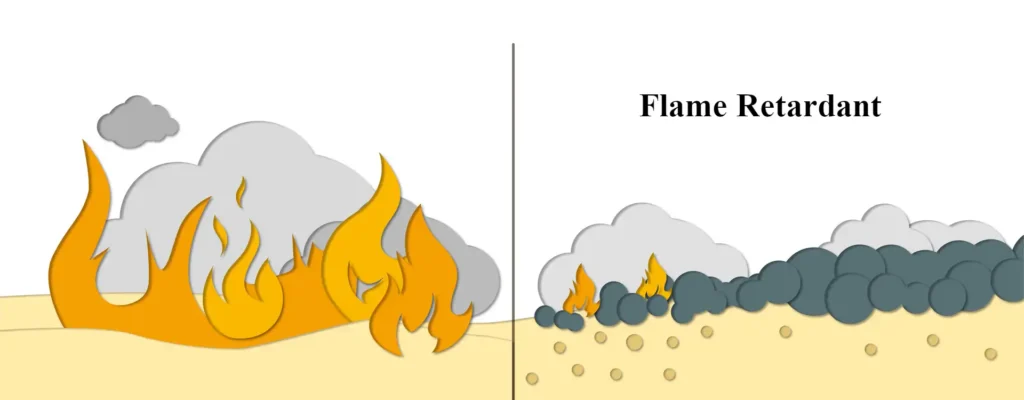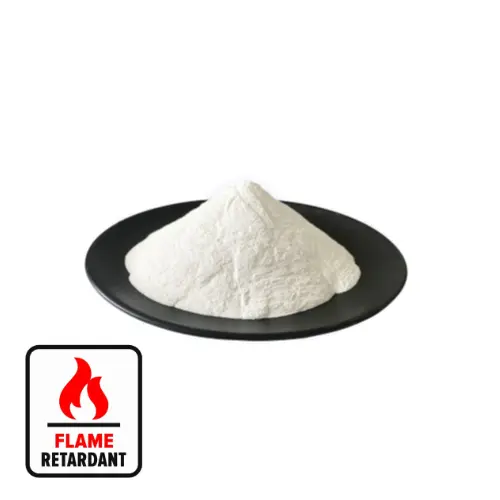Nanomagnesiumhydroxid: Nanomagnesiumhydroxid, Molekülformel Mg(OH)2, relative Molekülmasse 58,30. Weißes mikrofeines Pulver, ungiftig, geschmacksneutral, nicht ätzend, relative Dichte 2,36. Beginnt bei 350 °C zu zerfallen; zerfällt schnell bei 430 °C; zerfällt vollständig bei 490 °C. Löslich in starker Säurelösung und Ammoniumsalzlösung, unlöslich in Wasser. Schuppige Kristalle mit typischer nanolamellarer Struktur zerfallen bei 340 °C und erzeugen Magnesiumoxid. Unlöslich in Wasser, löslich in Säure und Ammoniumsalzlösung.

Das Produkt weist hervorragende Eigenschaften auf, wie beispielsweise hohe Reinheit, kleine Partikelgröße, In-situ-Beschichtungsmodifikation usw. Es lässt sich gleichmäßiger in Gummi- und Kunststoffprodukten wie PA, PP, ABS, PVC usw. verteilen. Es wird häufig in High-End-Produkten wie Gummi- und Kunststoffelastomeren, hochwertigen Kabelmaterialien und Haushaltsgeräten verwendet.
Bei fast nicht beeinträchtigter Gebrauchsfestigkeit werden die Flammschutz-, Rauchunterdrückungs- und Tropfschutzeigenschaften des Materials erheblich verbessert. Gleichzeitig wird das Nanomagnesiumhydroxid unter Verwendung geeigneter In-situ-Modifizierungsmethoden auch entsprechend den Kundenanforderungen hergestellt, um spezielles flammhemmendes Magnesiumhydroxid herzustellen. Mit seiner einzigartigen Dispersion wird Nanomagnesiumhydroxid in der Rüstungs-, Luftfahrt- und anderen Industriezweigen einen erheblichen Zuwachs erzielen. Die Nachfrage nach diesem Produkt wird in den nächsten fünf Jahren in Regionen wie Zentralasien-Pazifik und dem Nahen Osten steigen, mit einer erwarteten durchschnittlichen jährlichen Wachstumsrate von 9 % zwischen 2020 und 2025.
Die durchschnittliche Wachstumsrate des globalen Marktes für Flammschutzmittel beträgt von 2017 bis 2020 3,6 %, und der globale Markt für Flammschutzmittel beträgt 2017 etwa 6,5 Milliarden USD und 2020 7,2 Milliarden USD. Der globale Markt für Nanomagnesiumhydroxid wächst von 2017 bis 2020, und die Marktgröße des Marktes für Nanomagnesiumhydroxid beträgt 2017 1,18 Milliarden USD und 2020 1,94 Milliarden US-Dollar. 2020 beträgt die Marktgröße des chinesischen Marktes für Magnesiumhydroxid 1,457 Milliarden US-Dollar, wovon die Marktgröße für Nanomagnesiumhydroxid 763 Millionen US-Dollar beträgt, was einem Marktanteil von 52,38 % entspricht.
Chinas Wirtschaft und Gesellschaft entwickeln sich kontinuierlich und schnell, und die Lücke zwischen der Industrietechnologie und den Industrieländern wird immer kleiner. Es gibt genügend Gründe für die Annahme, dass Chinas Nano-Magnesiumhydroxid-Industrie aufholen und mit den Industrieländern der Welt gleichziehen wird. Die Magnesiumhydroxid-Industrie gilt als nachhaltige Zukunftsbranche. Mit der Nachfrage Asiens und dem Niveau der Industrieproduktion verschiebt sich das Zentrum des weltweiten Magnesiumhydroxid-Marktes, und China wird zur am schnellsten wachsenden Region der Magnesiumhydroxid-Marktnachfrage. Magnesiumhydroxid wird hauptsächlich als Füllstoff in Flammschutzmitteln, Kunststoffen, Gummi, Beschichtungen, Dichtungsmitteln und anderen Branchen verwendet. In den letzten Jahren ist mit der rasanten Entwicklung dieser Branchen die Nachfrage nach Magnesiumhydroxid weiter gestiegen, und die Flammschutz- und Kunststoffindustrie wird eine führende Rolle beim Wachstum der Nachfrage nach Magnesiumhydroxid spielen.
Erstens die globale Marktgrößenanalyse für Flammschutzmittel
Die durchschnittliche Wachstumsrate des globalen Marktes für Flammschutzmittel beträgt von 2017 bis 2020 3,6 %, und das globale Marktvolumen für Flammschutzmittel beläuft sich im Jahr 2017 auf etwa 6,5 Milliarden US-Dollar und im Jahr 2020 auf 7,2 Milliarden US-Dollar.
Zweitens (unterschiedliche) Anwendungsmarktanteilsanalyse
Mit der kontinuierlichen Entwicklung der modernen Industrie werden Polymermaterialien wie Kunststoffe, Gummi und synthetische Fasern häufig verwendet. Die überwiegende Mehrheit dieser organischen Polymerverbindungen ist jedoch brennbar und kann bei der Verbrennung große Mengen tödlicher giftiger Gase erzeugen. Um dieses Problem zu lösen und die Flammbeständigkeit synthetischer Materialien zu verbessern, ist die Zugabe von Flammschutzmitteln die effektivste Methode. In dieser Hinsicht haben sich Flammschutzmittel für die Zwecke der Flammschutzforschung und der Materialflammschutztechnologie in den letzten Jahren erheblich weiterentwickelt und sind zu einer der wichtigsten Komponenten des weltweiten Industriesystems geworden.
Derzeit sind Asien, Westeuropa und Nordamerika die weltweit größten Verbraucher von Flammschutzmitteln. Die USA und Westeuropa sind die Geburtsorte der Flammschutzmittel, die Industrie entwickelte sich früher und der Markt ist ausgereift und stabil. Die Flammschutzmittelindustrie in Asien begann spät, aber mit der rasanten wirtschaftlichen Entwicklung Chinas und Indiens ist die Flammschutzmittelindustrie schnell gewachsen und hat sich zum weltweit größten Verbrauchermarkt für Flammschutzmittel entwickelt.
Derzeit sind ausländische Flammschutzmittel hauptsächlich anorganische Systeme, von denen anorganische Flammschutzmittel mehr als 55 % des Marktanteils in Europa und den Vereinigten Staaten ausmachen und hauptsächlich Aluminiumhydroxid und Magnesiumhydroxid sind. Die in China produzierten und verbrauchten Flammschutzmittelarten sind hauptsächlich organische Flammschutzmittel, und der Anteil der Produktion und des Verbrauchs anorganischer Flammschutzmittel ist noch relativ gering. Mehr als 80 % der inländischen Flammschutzmittel sind Halogen-Flammschutzmittel.
Heute liegt der weltweite jährliche Verbrauch an Flammschutzmitteln bei über 2,25 Millionen Tonnen. Das am häufigsten verwendete Flammschutzmittel ist Aluminiumhydroxid mit einem Anteil von 38 %. Es folgen halogenierte Flammschutzsysteme mit bromierten und chlorierten Produkten, die meist zusammen mit dem Synergisten Antimontrioxid verwendet werden (insgesamt 31 %). Organophosphorhaltige und andere Flammschutzmittel wie anorganische Phosphorverbindungen, Stickstoff und zinkbasierte Flammschutzmittel machen die restlichen 31 % aus.
Unter den Anwendungen in der Branche werden die Verkäufe von Flammschutzmitteln für Bauanwendungen das stärkste Wachstum verzeichnen. Der Baumarkt wird auch den größten Anteil der weltweiten Nachfrage nach Flammschutzmitteln haben, etwa 28 %.

